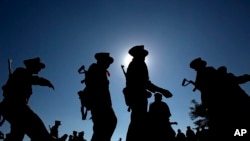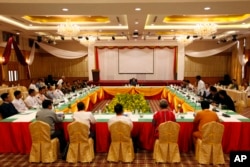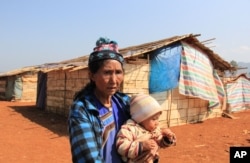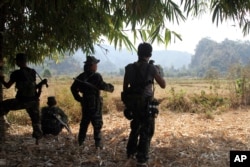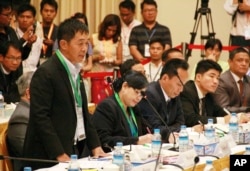Ethnic activists and community leaders from northern and southeastern Myanmar have condemned recent outbreaks of fighting, large-scale civilian displacement and alleged rights abuses in their areas.
Speaking at separate press conferences in Yangon last week, ethnic Ta’ang activists from Shan State and Karen activists from Karen State said the fresh violence showed the limits of the success of the peace process so far.
Some also claimed that military operations to secure areas for contentious hydropower dams are worsening the conflict.
Fighting between the Ta’ang National Liberation (TNLA) and the Myanmar military has affected northern Shan State since 2011, but Mai Cyruk, of the Ta’ang Student and Youth Organization said, “The conflict has worsened after the NCA was signed between the government army and the RCSS.”
In October 2015, the previous government signed the so-called Nationwide Ceasefire Accord (NCA) with eight rebel groups, including the Restoration Council of Shan State (RCSS).
A month later, RCSS troops moved north into TNLA areas, such as Namkham, Namsan, Mong Kung and Kutkhai townships, and clashed with Ta’ang fighters, whom claimed the RCSS operated with the support of the army.
Alleged abuses by army, rebels
Mai Cyruk said this year alone activists had documented dozens of cases of indiscriminate shelling, torture, rape, killings, forced recruitment and portering of Ta’ang civilians by both the army and RCSS fighters.
According to the UN, some 12,000 civilians were displaced by fighting in northern Shan State in the first half of 2016.
Mai Aung Kham, the Mong Kung Township chairman of the Ta’ang National Party (TNP), which holds several seats in parliament, said in July the RCSS had detained him, his father, uncle and two students, who are all party members.
“The RCSS threatened me, saying if I do not remove my TNP slogans, I will be forced to join the RCSS for 5 years. My father and uncle are still detained,” he told the press conference.
The Ta’ang and Shan rebel clashes have surprised many ethnic leaders and its exact reasons remain unclear. The RCSS could not be reached for comment, but has denied the abuses to local media.
The TNLA did not sign the NCA and, together with Kokang and Rakhine rebel groups, have been barred from the peace process by the still powerful army. This position appears to be a major obstacle to Aung San Suu Kyi’s plans for an inclusive nationwide ceasefire.
Mai Cyruk said for smaller, excluded ethnic groups such as the Ta’ang, the success of the peace process so far rings hollow. “I want to suggest that Aung San Suu Kyi should express and talk more about these ethnic groups… Without equal rights for the small ethnic groups, we cannot achieve true democracy.”
Thousands of Karen flee
The success of last year’s ceasefire deal also came into further question this month after the Myanmar army and a supporting militia began operations against a small rebel splinter group in Karen State’s Hlaingbwe Township.
The Karen National Union (KNU), a major rebel group that signed the NCA and has bases close to the fighting, warned the army on September 13 to end the operations as it was causing the “destruction of stability and peace in the region.” The operations have continued, nonetheless.
Naw Dah Dah, of the Karen Women’s Organization, told a press conference some 5,000 villagers had now fled to safer towns, while some 1,000 crossed into Thailand.
“Most are women and children. They had to run away through the jungle because they are afraid to use the road,” she said, adding that landmines were reportedly placed along roads, injuring two civilians and killing one on September 12.
Several Karen NGOs, including the Karen Environmental and Social Action Network, said government forces had moved closer to the planned, $2.6-billion Hatgyi Dam on the Salween River during operations against the rebel splinter group. They believed the operations could be a pretext for the army to secure the site.
Activists said a government militia requested access to the KNU-controlled western river bank near the dam site, but was rejected. KNU army chief General Saw Johnny was quoted by the NGOs as saying, “If they plan to build the dam, we will oppose it.”
Army shelling kills Kachin infant
In Kachin State, fighting between the army and the Kachin Independence Army has also increased in recent weeks, reducing humanitarian support for displaced civilians in rebel-held areas.
On Saturday, the army shelled a Kachin village in northern Shan State, killing a two-year-old infant and injuring two children, 5 and 6 years old, who were taken to a hospital in nearby China, according to Kachin activist Khon Ja. The incident prompted large protests in the Kachin capital Myitkyina on Monday.
The United States Embassy in Yangon said last week it was “deeply concerned” by the fighting in Kachin and warned it could “undermine the progress and goodwill generated by the recent Union Peace Conference.”
Several National League for Democracy (NLD) members were reluctant to discuss the increased fighting and referred to government officials involved with the peace process, who could not be reached.
Susanna Hla Hla Soe, a NLD lawmaker and Karen activist, only said, “When fighting happens, women and children always suffer… Our leaders would really like to build peace, but fighting still happens.”




